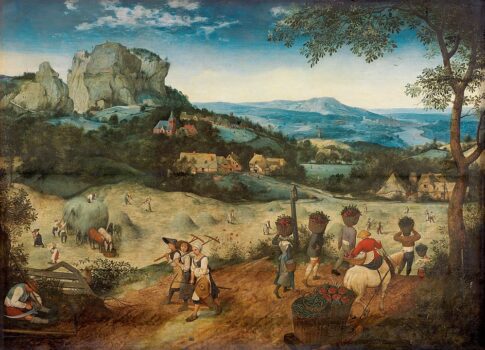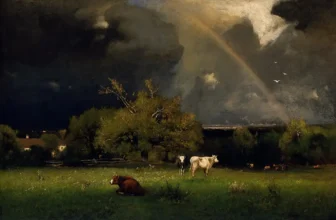Meaning of The Hay Harvest by Pieter Bruegel the Elder
Shopping Ads: Invest in Hidden Masterpiece: Rare Antique Oil Paintings For Sale. Limited Originals Available 💰😊 Are you looking for authentic hidden masterpiece? Explore old master antique oil paintings from the Renaissance and Baroque eras. From 16th-century portraits to 18th-century landscapes. Authenticity guaranteed, Old Master antique oil paintings for sale. Shop Now! 🎨 Renaissance And Baroque Art Old Master Portrait Paintings Landscape Antique PaintingsPieter Bruegel the Elder (c. 1525–1569) was one of the most original and influential painters of the Northern Renaissance. Known for his detailed landscapes, keen observation of human behavior, and allegorical richness, Bruegel captured the rhythms of everyday life with unparalleled vibrancy and depth. Among his most celebrated works is “The Hay Harvest” (1565), a painting that is both pastoral and philosophical, rooted in the land yet transcending time through its layered symbolism and rich detail.
This article delves into the full meaning, symbolism, historical context, painting technique, and legacy of “The Hay Harvest”, while also exploring what’s happening in the painting and where it is today.
Historical and Artistic Context
In the mid-16th century, Europe was undergoing significant changes, political unrest, the Reformation, shifts in agricultural practices, and early capitalism were reshaping the continent. In this context, Pieter Bruegel the Elder produced a groundbreaking series of paintings representing the Labors of the Months, a common medieval motif rooted in calendar manuscripts and Books of Hours.
Commissioned by the wealthy Antwerp merchant Niclaes Jonghelinck, the series originally comprised six large panel paintings, each depicting scenes corresponding to different months of the year. “The Hay Harvest” is believed to represent June or July, the season of hay cutting, marking the transition into the heart of summer.
While only five of these paintings survive today, “The Hay Harvest” is a luminous and serene centerpiece in this series.
Current Location of “The Hay Harvest”
Today, “The Hay Harvest” resides in the Lobkowicz Palace in Prague Castle, part of the private collection of the Lobkowicz family. Unlike other works in public museums, this piece remained in noble hands through centuries of war and upheaval.
Housed in the Lobkowicz Collections, it is one of the most treasured artworks in Central Europe. Visitors to Prague can view the painting in person, making it a rare opportunity to connect directly with a masterwork of Renaissance art in an intimate setting.
What’s Happening in the Painting?
At first glance, “The Hay Harvest” seems like a peaceful summer landscape dotted with peasants hard at work. However, closer observation reveals a tapestry of simultaneous human activities, combining labor, leisure, ritual, and nature into a singular moment of seasonal life.
Foreground
The foreground is dominated by peasants cutting hay. Some are bent over scythes, rhythmically sweeping through golden fields. Others gather the hay into bundles or pitch it onto carts drawn by oxen. The physical exertion is palpable; you can almost feel the sun’s heat on their backs.
To the right, a group of men rest under a tree, eating and drinking. One man lies asleep while others laugh, converse, or play music. This juxtaposition of labor and leisure is one of Bruegel’s hallmarks, reminding us of the cyclical balance between work and rest.
Middle and Background
The middle ground transitions into pastoral hills and clusters of trees. Cows graze in lush meadows, and more workers harvest the fields. A winding path draws the eye to the background, where a village appears nestled in rolling hills. Beyond that, the sea or a wide river glimmers in the distance, suggesting the vastness of the world beyond this moment.
Each area of the painting contains a “micro-story” that together creates a panoramic vision of rural life. No single narrative dominates; instead, life unfolds organically across the canvas.
Painting Technique and Style
Bruegel was trained in the workshop of Pieter Coecke van Aelst and was heavily influenced by Italian Renaissance art after traveling to Italy in the 1550s. However, he developed a style distinct from the idealism of Italian masters.
In “The Hay Harvest,” Bruegel employs oil on wood panel, a common medium of the time, allowing for both fine detail and luminous color. His palette is warm, dominated by earthy golds, greens, and browns that evoke the ripeness of summer.
Key stylistic elements include:
High horizon line: Bruegel uses a traditional Northern Renaissance device that allows viewers to take in an expansive scene from a bird’s-eye perspective.
Atmospheric depth: The fading blues and greens of the background create a sense of distance and weather.
Figural naturalism: The bodies are not idealized; they are real peasants with sturdy forms, dirty hands, and worn clothes.
This is genre painting at its finest, a realistic, though composed, depiction of everyday life.
Symbolism and Deeper Meaning
Bruegel’s works often contain hidden meanings, witticisms, and warnings wrapped in the fabric of everyday scenes. “The Hay Harvest” is no exception.
a. Cycles of Life and Time
As part of the Labors of the Months, the painting inherently symbolizes the passage of time. Each season has its toil, and June/July represents a time of productivity and effort, but also of ripeness and bounty. The hay, ephemeral and golden, is emblematic of life’s fleeting nature, especially when seen through a vanitas lens prevalent in the Renaissance.
b. Labor and Leisure
One of the painting’s key symbolic tensions is between work and rest. The toiling farmers in the fields represent diligence and the Protestant work ethic, while the resting men suggest indulgence or perhaps a well-earned reprieve. Bruegel doesn’t judge either state directly, he presents both as natural parts of the human experience.
c. The Earth and the Sacred
Though no overt religious imagery is present, the painting is deeply spiritual in its affirmation of the sacred rhythms of nature. In Bruegel’s worldview, divinity is not distant, but embedded in the cycles of the land and the dignity of ordinary people. The act of harvesting becomes a kind of sacred ritual.
d. Social Commentary
Some art historians argue that Bruegel offers subtle critiques of social inequality. While peasants labor in the fields, distant signs of aristocratic life (such as the manor house or village structures) lurk in the background. However, “The Hay Harvest” is more bucolic and idyllic than accusatory, unlike some of Bruegel’s more pointed works like “The Blind Leading the Blind.”
What Does The Painting Mean?
“The Hay Harvest” is not simply a painting of peasants in a field, it’s a meditation on humanity’s place within nature, the passage of time, and the value of humble life.
Where some Renaissance painters focused on mythological grandeur or Biblical drama, Bruegel found epic meaning in the ordinary. His peasants are not caricatures but human beings, full of dignity, humor, and resilience.
This artwork can be seen as:
An homage to the working class, whose labor sustains civilization.
A celebration of seasonal rhythms, where each phase of the year has its own character.
A reflection on the harmony between man and nature, a theme increasingly relevant today.
Influence and Legacy
Bruegel’s Labors of the Months series, including “The Hay Harvest,” had a profound influence on later genre painting, particularly in the Dutch Golden Age. Artists like Pieter Brueghel the Younger, Jan Brueghel the Elder, and David Teniers would carry on this tradition.
More broadly, Bruegel’s vision helped establish the idea that everyday life was a worthy subject of fine art, a radical idea at the time. Without him, there would be no Vermeer’s interiors, no Courbet’s realism, no Van Gogh’s wheatfields.
The Painting Today: A Living Legacy
In modern times, “The Hay Harvest” remains a favorite among art lovers, historians, and philosophers. Its enduring appeal lies in its accessibility, anyone can understand it at a glance, combined with its depth, inviting years of contemplation.
In an era increasingly disconnected from the land and seasons, Bruegel’s work calls us back to slowness, observation, and respect for nature’s rhythms. It doesn’t preach; it simply shows life unfolding as it is.
“The Hay Harvest” by Pieter Bruegel the Elder is much more than a beautiful landscape. It is a visual symphony of labor and leisure, humanity and nature, motion and stillness. Painted with exquisite detail and subtle wisdom, it is a testament to Bruegel’s genius and a window into a world both distant and deeply familiar.
The painting encapsulates the very essence of Renaissance Northern art, not through grandiose mythologies, but through the poetic realism of rural life. In its sunlit fields and weather-worn peasants, we find ourselves, our labors, our joys, our seasons of growth and rest.
Five centuries later, it continues to speak, not just to the eye, but to the soul.
Quick Facts Recap:
Title: The Hay Harvest
Artist: Pieter Bruegel the Elder
Date: 1565
Medium: Oil on wood panel
Dimensions: Approx. 113.5 x 158.5 cm
Location: Lobkowicz Palace, Prague Castle, Czech Republic
Series: Part of “Labors of the Months”
Style: Northern Renaissance, Genre Painting
Themes: Seasons, Labor, Rural Life, Nature, Symbolism




